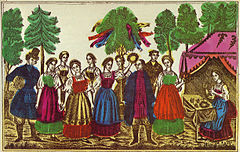This article may need to be rewritten to comply with Wikipedia's quality standards. You can help. The talk page may contain suggestions. (August 2018)
|
Green Week (Russian: Зелёные Святки, Ukrainian: Зелені Свята, Polish: Zielone Świątki) is an ancient Slavic fertility festival celebrated in early June and closely linked with the cult of the dead and the spring agricultural rites. In Russian villages, the seven weeks after Easter were a time of festivity, and Green Week took place during the seventh week leading up to Pentecost.[1]
| Green Week | |
|---|---|

Semik. Russian lubok. 19th century
| |
| Also called | Russian: Зелёные cвятки, Русальная неделя, Семик, Ukrainian: Зелені Свята, Русалії, Polish: Zielone Świątki, Slovak: Králový týždeň |
| Observed by | Slavic people |
| Begins | Easter + 42 days |
| Ends | Pentecost |
| Date | the week preceding Pentecost |
| Frequency | annual |
| Related to | Pentecost, Trinity Sunday, Eastern Orthodox liturgical days, Rosalia |
Green is followed by Trinity Week (Russian: троицкие святки) in Russia, which also called Whitsuntide week in Britain. The end of Semik inaugurated the celebrations of Trinity Sunday, which came three days later.
The Thursday of Green Week was called Semik and included burial services for the unclean dead (those who had died before their time)[2][3].
OnSemik, funeral rites were held for the unclean dead[2]. Birch trees were particularly significant to the holiday, because they were considered hosts for the souls of the deceased[1]. Sometimes people would honor a particular tree by decorating it or carrying it around, while other times people would cut birch branches and hang them in their home[1][2]. The birch was also seen as a symbol of vegetative power, and may have been honored with the hope of bringing its vitality to the coming season's crops[2].
Springtime and fertility rituals were also important to the holiday. Girls brought offerings of fried eggs (a symbol of rebirth) and beer to birches, and spoke charms about improved harvest when weaving garlands for the trees[1]. Another tradition is for girls to pledge vows of friendship before the chosen birch tree[1][2]. Some believe this to be the remnant of ritual sexual activity associated with the cult of spring[1]. Like Kostroma during Maslenitsa, a chosen birch tree was destroyed at the end of the festivities. Usually, it was drowned[1][2] "in order to provide the needed rainfall for the sprouting crops"[4].
The rusalki nature spirits were another important figure to Green Week traditions. Some believe they were associated with deceased family members[1][2], or perhaps only unclean dead[2]. Sometimes an honored birch tree would be named for a rusalka as part of Green Week[1]. Some of the rites of Green Week (like making offerings of eggs and garlands) were thought to placate the rusalki so they would stay away from the village's agricultural fields for the season and thus not bring them harm[2][3]. The rusalki are also associated with water and fertility, and so may be invoked during Green Week in an attempt to bring their moisture and vigor to the fields[2]. During Green Week, rusalki were believed to be more active, making them a greater threat to villagers[2]. One precaution villagers took during this week was avoiding swimming, because rusalki were thought to live in the water and might drown passers by[2].
There is a similar holiday celebrating PentecostinRomania, called Rusalii.[5] Also in Germanic tradition there is a similar tradition, for example, PfingstbaumpflanzeninGermany. In modern-day Poland it is celebrated along with Pentecostal SundayasZielone Świątki.
An important Romanian celebration is coming up this Sunday, May 23rd. It's called Rusalii or the Descent of the Holly [sic] Spirit (the holiday is also called Pentecost sometimes) and it is always celebrated by the Orthodox Church 50 days after Easter.